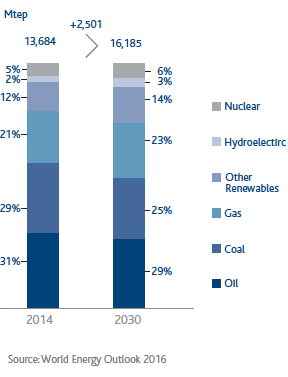The future of natural gas in the energy system
Global energy demand is projected to increase over the next fifteen years, especially due to the impetus of emerging (non-OECD) countries. These shall offset the contraction of demand in OECD countries, whose consumption should also decline due to the effect of energy efficiency policies. To date requirements are still mainly covered by coal and oil.
By contrast, at the European level a significant presence of gas and nuclear energy in the energy mix has been recorded, with respective shares of 22% and 14%, with a lower weight for coal (17%) in comparison with the worldwide share, and with a marked regional differentiation within the European market.
In Italy gas plays a more significant role in comparison with other European countries, and covers one third of energy requirements. At the beginning of the decade our country experienced strong growth in renewable sources due to significant financial support for growth in the sector, which represents 18% of the energy mix.
Looking prospectively, the weight of fossil sources worldwide is projected to gradually decline (81% in 2014, compared with a projected 76% for 2030), while gas shall play an increasingly more significant role, with an increase representing approximately the equivalent of 790 megatonnes of oil in 2030. A significant increase in renewables is also forecast.
This trend is even more marked at the European level, where it is possible to observe a decisive contraction in the demand for oil and coal and a substantial increase in demand for gas (approximately 50 Mtep) and renewables, in consideration of changes in the industrial footprint and, above all, energy efficiency policies and a reduction in carbon dioxide emissions.
Changes in the energy mix: the end of the era of oil and the increasing use of gas
ENERGY MIX IN THE WORLD

ENERGY MIX IN EUROPE

The modernity and sustainability of the gas system
Natural gas is the “greenest” source of fossil energy and the only fuel that, in combination with non-programmable sources such as wind and solar power, can ensure an efficient and effective path towards decarbonisation on national and European levels. Gas in its various forms guarantees lower carbon dioxide emissions, by 25% to 40% compared with other fossil fuels, as well as lower emissions of nitrogen oxides and fine particulates, with a crucial and determining impact on measures to fight air pollution in cities, and would contribute to a reduction in the role of oil and oil derivatives.
Gas is also accessible, given the presence of considerable reserves in areas close to Europe and the growth of the worldwide liquefied natural gas market, which has increased availability at reduced prices.
The gas system can rely upon existing transportation, distribution and storage infrastructure and is capable of ensuring flexibility, programmability, and cost effectiveness for the energy system. This is also due to a gas electrical generation capacity which in Italy is already widely available and extremely efficient.